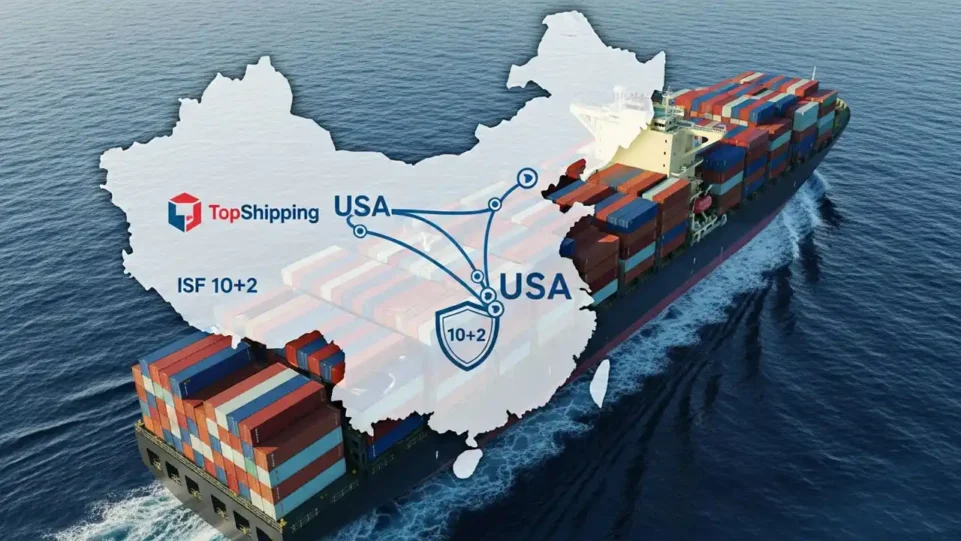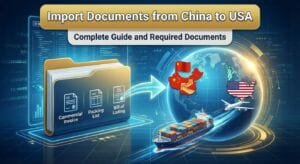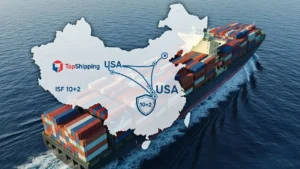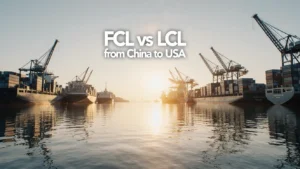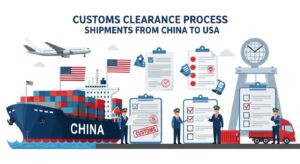If you’re importing goods from China to the United States, there’s one critical compliance requirement you cannot afford to overlook: Importer Security Filing (ISF), commonly known as ISF 10+2.
Missing an ISF deadline or submitting incorrect information can result in penalties up to $5,000 per violation, cargo holds at the port, and costly delays that impact your entire supply chain. For businesses relying on predictable delivery schedules whether you’re an Amazon FBA seller, a hardware wholesaler, or a retail importer ISF compliance is non-negotiable.
This comprehensive guide explains everything you need to know about importer security filing: what it is, who must file it, the exact deadlines, required data elements, penalties, and how to ensure compliance. We’ll also show you how partnering with an experienced freight forwarder like TopShipping can eliminate the complexity and risk from the ISF process.
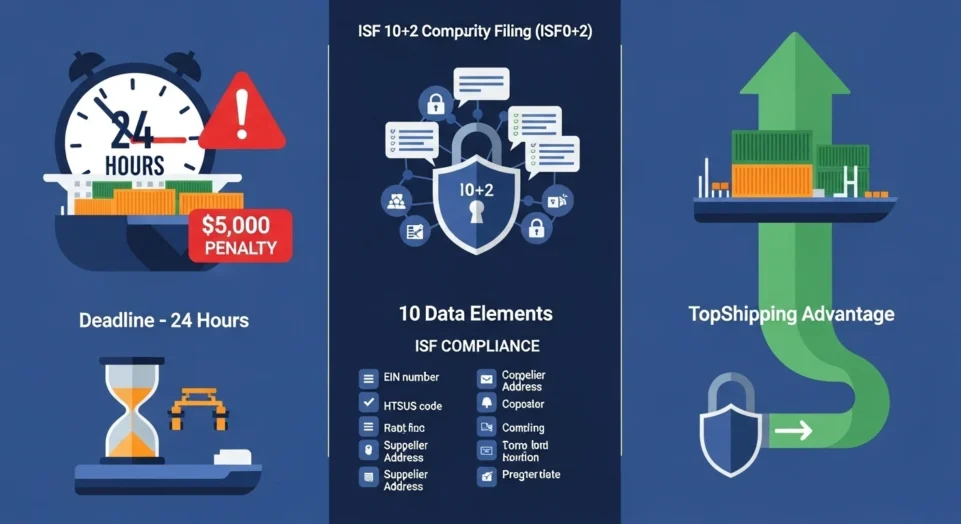
What Is Importer Security Filing (ISF)?
Importer Security Filing (ISF), also known as “10+2”, is a U.S. Customs and Border Protection (CBP) security regulation established under the SAFE Port Act of 2006 and implemented in January 2009.
The ISF requires importers or their agents to electronically submit specific cargo information to CBP before goods are loaded onto a vessel bound for the United States. The regulation applies exclusively to shipments from China to the US arriving by container vessel.
Why ISF Exists: Importer Security Filing Meaning
The primary objective of ISF is to enhance U.S. border security by giving CBP advance information about incoming cargo. This allows customs officials to:
- Assess security risks before goods arrive at U.S. ports
- Identify potential threats including terrorism, smuggling, and contraband
- Prevent dangerous or prohibited items from entering the country
- Streamline the inspection process for legitimate cargo
In essence, CBP wants to know what’s coming, who sent it, and who’s receiving it before the container ship even leaves the foreign port.
Who Must File the ISF?
The responsibility for filing the importer security filing falls on the “ISF Importer” which CBP defines as:
- The goods owner, or
- The purchaser, or
- The consignee (if neither owner nor purchaser is identifiable at the time of filing)
In practice, most importers hire a licensed customs broker or their freight forwarder to file the ISF on their behalf. However, legal liability always remains with the importer, even when using a third party.
Common ISF Filing Scenarios
| Business Type | Who Typically Files ISF |
|---|---|
| Amazon FBA Seller | Customs broker or freight forwarder |
| Direct Importer (FOB/EXW terms) | Customs broker hired by importer |
| Buyer using DDP service | Freight forwarder (TopShipping handles this) |
| Freight Consolidator | Customs broker or NVOCC |
Important: If you’re importing under DDP (Delivered Duty Paid) terms, confirm with your logistics provider whether ISF filing is included in their service package.

ISF Deadline: The Critical 24-Hour Rule
This is where many importers make costly mistakes.
ISF must be filed at least 24 hours before cargo is loaded (laden) onto the ocean vessel at the foreign port of departure.
Key Timing Points:
- ISF filing deadline: 24 hours before loading at origin port (e.g., Shenzhen, Shanghai)
- Not to be confused with: The 24-Hour Manifest Rule, which applies to carriers
- Updates allowed: You can update ISF information up until 24 hours before U.S. arrival
Example Timeline:
Your cargo is scheduled to load onto a vessel in Shenzhen on February 15 at 2:00 PM local time.
- ISF must be filed by: February 14 at 2:00 PM (24 hours prior)
- Filing after this deadline: Violation subject to penalties
Pro Tip: Build buffer time. If your supplier confirms a sailing date, file ISF immediately don’t wait until the last minute. Vessel schedules can change, and last-minute scrambles often lead to errors.
ISF 10+2 Data Elements Explained
The term “10+2” refers to the structure of the ISF filing:
- 10 data elements provided by the importer
- +2 data elements provided by the carrier (shipping line)
10 Elements from Importer
These are the importer’s responsibility to submit:
1. Importer of Record Number
The IRS number, EIN, or Social Security Number of the entity responsible for customs compliance and payment of duties.
Example: 12-3456789 (EIN)
2. Consignee Number
The IRS/EIN of the party to whom the goods will be delivered in the U.S.
Example: 98-7654321
3. Seller (Owner) Name and Address
The last known entity that sold the goods to the buyer or transferred ownership.
Example:
Guangzhou Electronics Co., Ltd.
Building 5, Industrial Park, Tianhe District
Guangzhou, Guangdong, China
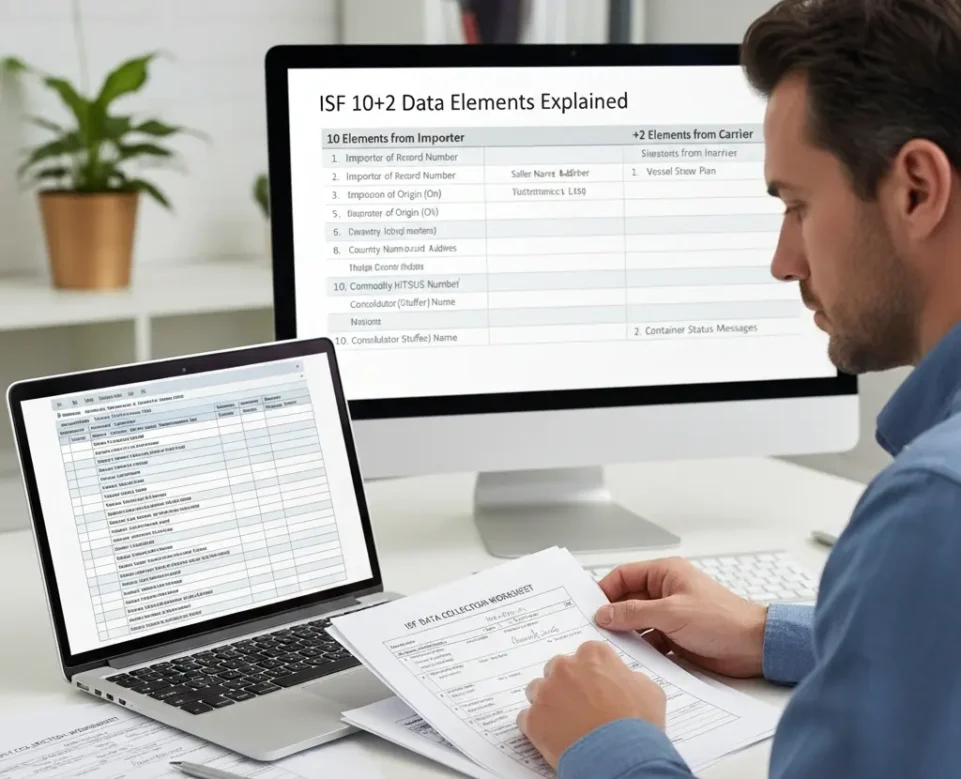
4. Buyer (Owner) Name and Address
The last known entity to whom the goods are sold or transferred.
Example:
ABC Imports LLC
1234 Commerce Street
Los Angeles, CA 90001, USA
5. Manufacturer (Supplier) Name and Address
The entity that last manufactures, assembles, produces, or grows the commodity—or the supplier of the finished goods.
Example:
Shenzhen Tech Manufacturing Ltd.
Unit 8, Electronics Zone
Shenzhen, China
6. Ship-to Party Name and Address
The first deliver-to party scheduled to physically receive the goods after release from customs.
Example:
Amazon Fulfillment Center ONT2
24208 San Michele Road
Moreno Valley, CA 92551, USA
7. Country of Origin
The country where goods were manufactured, produced, or grown, as determined by U.S. Customs rules of origin.
Example: CN (China)
8. Commodity HTSUS Number (6-digit minimum)
The Harmonized Tariff Schedule classification code for the goods.
Example: 8517.62 (for smartphones)
Note: While entry filing requires 10-digit HTSUS, ISF only requires 6 digits minimum.
9. Container Stuffing Location
The physical location where the container was stuffed (loaded).
Example:
Yantian Container Terminal
Shenzhen, Guangdong, China
10. Consolidator (Stuffer) Name and Address
The party who stuffed the container or arranged for stuffing.
Example:
TopShipping Logistics Shenzhen
Suite 1203, Building A, Huaqiang Plaza
Shenzhen, China
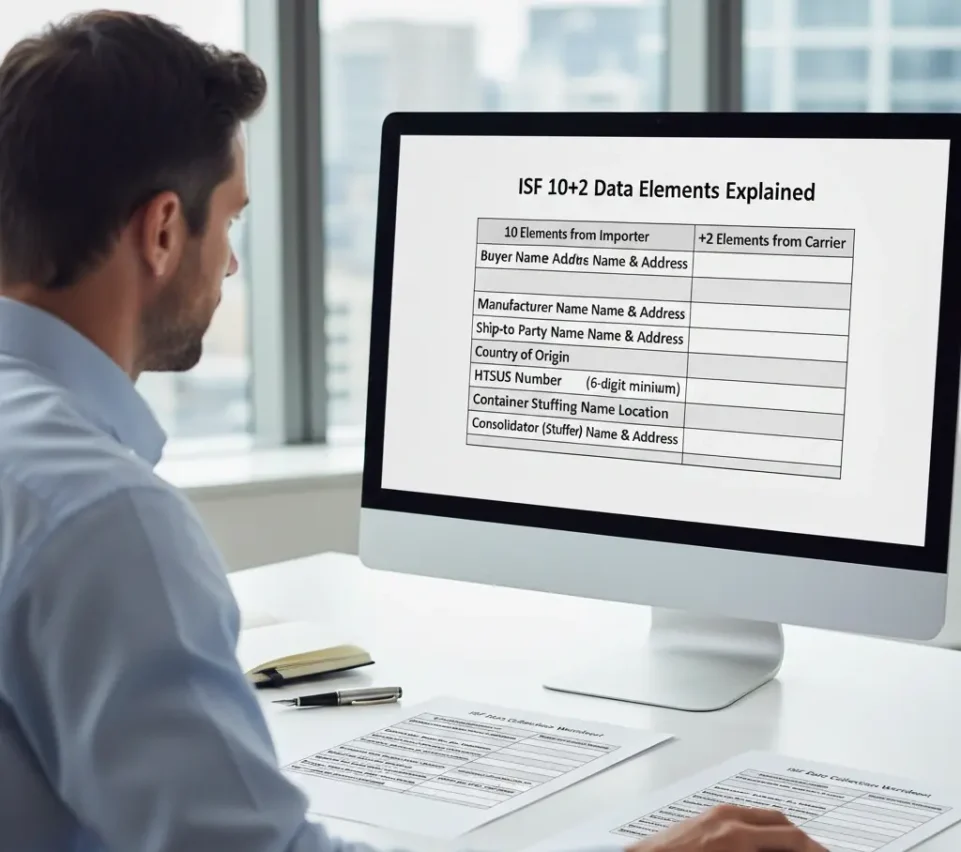
+2 Elements from Carrier
These are provided by the ocean carrier (shipping line):
1. Vessel Stow Plan
Details on how and where containers are stowed on the vessel.
2. Container Status Messages (CSM)
Real-time tracking updates on container movements, including:
- Arrival at terminal
- Loading onto vessel
- Departure from port
Note: Importers do not need to provide these elements—the carrier submits them directly to CBP.
Importer Security Filing Requirements (2025 Update)
Who Must Comply with ISF?
ISF applies to:
- All containerized ocean cargo entering the U.S.
- Imports via FCL (Full Container Load) and LCL (Less than Container Load)
- Both commercial goods and certain personal shipments
Who Is Exempt from ISF?
- Air freight shipments (ISF does not apply to air cargo)
- Bulk cargo (non-containerized goods like grain, oil, coal)
- Break bulk cargo (oversized items loaded individually)
- FROB (Foreign Remaining on Board) cargo that does not enter U.S. commerce
ISF-5 Exception:
For specific scenarios (FROB, Immediate Export, T&E shipments), a simplified ISF-5 filing with only 5 data elements is required instead of the full ISF-10.
What Is an ISF Bond? (Importer Security Filing Bond)
An ISF Bond is a financial guarantee that ensures compliance with ISF regulations and covers potential penalties if violations occur.
CBP requires importers to have an active bond before filing an ISF.
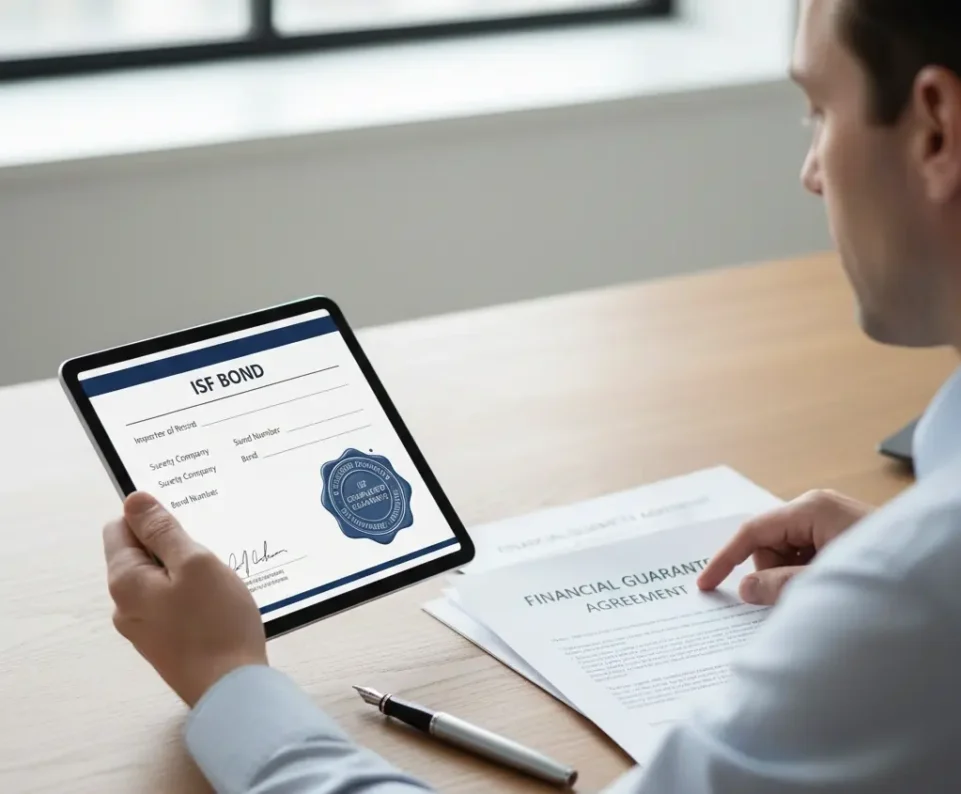
Types of ISF Bonds
1. Single ISF Bond (Single Entry Bond)
- Covers one specific shipment
- Cost: Typically $50–$70 per shipment
- Best for: Occasional importers or first-time buyers
2. Continuous Customs Bond
- Covers all shipments for one year
- Minimum cost: $500–$1,000/year (based on import value)
- Best for: Regular importers with multiple shipments annually
Example:
If you import 20 containers per year, a continuous bond saves you approximately $500+ annually compared to individual single bonds.
How to Obtain an ISF Bond
- Purchase through a licensed customs broker
- Work with a surety company authorized by CBP
- Your freight forwarder (like TopShipping) can coordinate bond procurement
Important: Your ISF cannot be filed without an active bond. Plan ahead to avoid delays.
ISF Filing Fee: How Much Does It Cost?
ISF filing itself is not charged by CBP—but you’ll incur fees from service providers.
Typical ISF Costs (2025)
| Service | Cost Range |
|---|---|
| Customs Broker ISF Filing Fee | $30–$75 per filing |
| Single ISF Bond | $50–$70 |
| Continuous Bond (annual) | $500–$1,000+ |
| Total (Single Shipment with Single Bond) | $80–$145 |
Cost vs. Risk
- ISF filing cost: ~$100
- ISF penalty for late/incorrect filing: $5,000
The cost of compliance is a fraction of the penalty. Professional ISF filing is always a smart investment.
TopShipping Advantage: When you ship DDP with TopShipping, ISF filing and bond coordination are handled as part of our complete China to US customs clearance service—no surprise fees, no missed deadlines.
ISF Penalties: What Happens If You Miss the Deadline?
CBP takes ISF compliance seriously. Violations can result in severe financial and operational consequences.
ISF Penalty Structure (2025)
| Violation Type | Penalty Amount |
|---|---|
| Late filing (after 24-hour deadline) | Up to $5,000 |
| Inaccurate or incomplete data | Up to $5,000 |
| Failure to update ISF | Up to $5,000 |
| Repeat violations | Up to $10,000 |
Additional Consequences:
- Cargo hold: CBP can refuse to release your shipment until the ISF is corrected
- Intensive examination: Your cargo may be flagged for 100% physical inspection
- Demurrage and storage fees: Detention charges accumulate daily at the port
- Supply chain disruption: Delays impact inventory, sales, and customer commitments
- C-TPAT membership impact: Violations may affect your Customs-Trade Partnership Against Terrorism status

Penalty Mitigation
CBP may reduce penalties by 50% if:
- The violation was the first offense
- The importer is a C-TPAT certified member
- The importer demonstrates a history of compliance
Case Study:
A U.S. electronics importer failed to file ISF for three consecutive shipments due to supplier communication issues. CBP assessed a total penalty of $15,000. The importer’s appeals process took 6 months, during which two shipments were held, resulting in lost Amazon sales and demurrage charges exceeding $8,000.
Lesson: Proactive ISF management prevents expensive penalties and operational nightmares.
ISF Form Examples & Templates
Many importers ask: “Where can I find the official ISF form?”
The answer: There is no official paper ISF form.
ISF filings are submitted electronically through CBP’s Automated Commercial Environment (ACE) portal. The data is transmitted in a structured electronic format.
What You Need to Provide
Instead of filling out a form, you’ll compile the 10 data elements listed earlier and provide them to your customs broker or freight forwarder, who will input the information into ACE.
ISF Information Worksheet
While there’s no “official form,” many brokers use an ISF Data Collection Worksheet to gather information from importers.
Example template structure:
ISF DATA COLLECTION WORKSHEET
1. Importer of Record Number (EIN/IRS): _______________
2. Consignee Number: _______________
3. Seller Name: _______________
Address: _______________
4. Buyer Name: _______________
Address: _______________
5. Manufacturer/Supplier Name: _______________
Address: _______________
6. Ship-to Party: _______________
Address: _______________
7. Country of Origin: _______________
8. HTSUS Code (6-digit): _______________
9. Container Stuffing Location: _______________
10. Consolidator Name: _______________
Address: _______________
Pro Tip: Create a standardized ISF data template for your suppliers. Request they complete it with every purchase order. This ensures accuracy and speeds up the filing process.
ISF vs. Other Regulations
ISF for Air Shipments
ISF does not apply to air freight.
Air cargo entering the U.S. is subject to different advance manifest requirements, but not ISF 10+2.
If you’re shipping via air from China to the USA, you do not need to file an importer security filing.
Relevant for: Amazon FBA sellers using air freight for time-sensitive restocks.

ISF for Break Bulk Cargo
Break bulk cargo (non-containerized goods like machinery, steel, or oversized equipment) is exempt from ISF.
However, standard customs entry filing and other CBP requirements still apply.
Who Is Responsible for ISF Filing Errors?
This is a critical question and the answer often surprises importers.
The ISF Importer bears ultimate responsibility for ISF accuracy and timeliness, even if a customs broker or freight forwarder files on their behalf.
Common Misconceptions
“My broker filed the ISF, so if there’s a penalty, it’s their problem.”
Reality: CBP holds the importer of record legally liable. While you may have contractual recourse against your broker for negligence, the penalty notice will be issued to you.
Protecting Yourself
- Choose experienced service providers: Work with reputable customs brokers and freight forwarders
- Verify ISF accuracy: Review all data before submission
- Maintain communication: Ensure your supplier provides accurate information
- Keep records: Document all ISF submissions and confirmations
- Use DDP services: Partner with providers like TopShipping who manage the entire process and ensure compliance
How ISF Is Enforced in 2025
CBP has increased ISF enforcement significantly since 2015.
Current Enforcement Practices
- Port-level authority: Individual ports can issue liquidated damages directly (not centralized)
- 90-day window: CBP has 90 days from vessel arrival to issue penalty notices
- Data verification: CBP cross-checks ISF data with entry documentation, carrier manifests, and historical records
- Automated flagging: The ACE system automatically flags late or missing ISF filings

What Triggers an ISF Penalty?
- ISF filed after the 24-hour deadline
- Missing or incomplete data elements
- Inaccurate information (e.g., wrong HTSUS, incorrect addresses)
- Failure to update ISF when information changes
- No ISF filed at all
Best Practice: Treat ISF as seriously as customs entry filing. Accuracy and timeliness are non-negotiable.
How to File Importer Security Filing: Step-by-Step
Here’s the process for compliant ISF filing:
Step 1: Gather the 10 ISF Data Elements
Collect accurate information for all required fields (see “ISF 10+2 Data Elements” section above).
Tips:
- Request ISF information from your supplier with every purchase order
- Verify manufacturer and stuffing location details
- Confirm HTSUS codes with your customs broker
Step 2: Secure an ISF Bond
Ensure you have either:
- A single ISF bond for the shipment, or
- An active continuous customs bond covering all imports
Your customs broker can arrange bond procurement if needed.
Step 3: Choose a Filing Method
Option A: Hire a Customs Broker
Most importers use a licensed broker to file ISF. Brokers have ACE access, expertise, and assume some filing risk.
Option B: Self-Filing via ACE
If you’re a registered importer with ACE portal access, you can file ISF yourself. However, this requires technical knowledge and compliance expertise.
Option C: Use a Full-Service Freight Forwarder
Companies like TopShipping handle ISF as part of DDP shipping services simplifying the entire process.
Step 4: Submit ISF at Least 24 Hours Before Loading
Once all data is verified, your broker or forwarder submits the ISF electronically to CBP.
Confirmation: You’ll receive an ISF confirmation number as proof of filing.
Step 5: Monitor and Update as Needed
If any ISF information changes after initial filing (e.g., consignee address, vessel details), you must update the ISF before the cargo arrives at the U.S. port.
Deadline for updates: 24 hours before U.S. arrival
Step 6: Track ISF Status
Monitor your ISF status through your customs broker or ACE portal. Ensure CBP accepts the filing without rejections or holds.

The Role of TopShipping in ISF Filing
ISF compliance can be complex especially for businesses new to importing or managing multiple shipments. That’s where TopShipping makes the difference.
How TopShipping Simplifies ISF for You
Complete ISF Management
When you ship DDP (Delivered Duty Paid) with TopShipping from China to the USA, we handle every aspect of ISF filing:
- Collecting accurate data from your suppliers
- Coordinating with our trusted U.S. customs brokers
- Filing ISF within the 24-hour deadline
- Managing ISF bonds (single or continuous)
- Updating ISF if shipment details change
You focus on your business. We ensure compliance.
Avoid Costly Penalties
Our logistics experts track vessel schedules, monitor filing deadlines, and verify data accuracy eliminating the risk of $5,000 penalties.
We’ve successfully filed thousands of ISF submissions with a 99.9% on-time rate and zero penalties for our clients.
Transparent Communication
We keep you informed at every step:
- ISF confirmation numbers sent immediately upon filing
- Real-time shipment tracking from China to your U.S. warehouse
- Proactive alerts if any updates are needed
Seamless Integration with Customs Clearance
ISF is just one piece of the import puzzle. TopShipping coordinates:
- ISF filing (before loading in China)
- Customs entry filing (upon U.S. arrival)
- Duty and tax payment
- Final delivery to your warehouse or Amazon FBA
One partner. One streamlined process. Zero headaches.

Real Client Success Story
Client: U.S. Amazon FBA seller importing electronics from Shenzhen
Challenge: Previous freight forwarder missed ISF deadlines twice, resulting in a $5,000 penalty and 7-day cargo hold
Solution: Switched to TopShipping’s DDP service
Result:
- 100% on-time ISF filing for 36 consecutive shipments
- Faster port clearance (avg. 24 hours)
- Improved inventory planning and cash flow
“TopShipping took the stress out of ISF compliance. I used to lose sleep worrying about deadlines. Now I just send my PO, and they handle everything. Best decision I made for my business.”
Michael T., Amazon FBA Seller
Conclusion: Why ISF Compliance Matters for Your Business
Importer Security Filing is more than a regulatory checkbox it’s a critical component of secure, efficient, and cost-effective importing from China to the United States.
The Bottom Line
- ISF is mandatory for all ocean freight entering the U.S.
- Late or inaccurate filing can cost you $5,000+ in penalties and cause serious supply chain disruptions
- Professional management ensures compliance, protects your business, and gives you peace of mind
Why Work with TopShipping for ISF Compliance
When you partner with TopShipping for your China-to-USA shipments, you get:
- Expert ISF filing by experienced customs brokers
- Proactive deadline management to avoid penalties
- Transparent communication throughout the process
- Complete DDP service including ISF, customs clearance, and China to USA door-to-door delivery
- 24/7 support in English, French, and Chinese
We’ve helped hundreds of Amazon FBA sellers, wholesalers, and retail importers navigate ISF requirements successfully—delivering on-time, penalty-free shipments every time.

FAQ: Importer Security Filing
Can I file ISF myself?
Yes, if you’re a registered importer with access to CBP’s ACE portal. However, most businesses hire a licensed customs broker due to the technical complexity and compliance risk. Filing errors can result in $5,000 penalties.
Who is responsible for filing ISF-5?
ISF-5 applies to Foreign Remaining on Board (FROB), Immediate Export (IE), and Transportation & Exportation (T&E) shipments. The party responsible varies:
- FROB/IE: The carrier or NVOCC typically files
- T&E: The importer or their customs broker
Clarify filing responsibility in your shipping contracts.
What if my supplier gives me wrong information for ISF?
You, as the ISF Importer, remain responsible for accuracy—even if your supplier provides incorrect data. If a penalty is issued due to supplier errors, you may have contractual recourse against the supplier, but CBP will hold you liable.
Best Practice: Verify all supplier-provided information before ISF submission. Work with experienced freight forwarders like TopShipping who validate data before filing.
How is ISF different from customs entry filing?
| ISF Filing | Customs Entry Filing |
|---|---|
| Filed before loading at origin | Filed upon arrival at U.S. port |
| Requires 10 data elements | Requires full commercial invoice, packing list, etc. |
| Security/risk assessment | Duty calculation and collection |
| Deadline: 24h before loading | Deadline: 15 days after arrival |
Both are required for legal importation. ISF is a security filing; entry is a customs declaration.
Do I need ISF for shipments to Canada or the UK?
No. ISF (Importer Security Filing) is a U.S.-only requirement. Canada, the UK, Netherlands, and other countries have their own import regulations, but they do not require ISF.
For Canadian imports, you’ll need to comply with CBSA (Canada Border Services Agency) requirements, which are different from ISF.
What is the penalty for filing ISF late?
CBP can assess penalties up to $5,000 for each late ISF filing. Repeat violations can result in penalties up to $10,000. Additionally, late filing can cause cargo holds, intensive inspections, and demurrage charges at the port.
Can I update my ISF after filing?
Yes, you can—and should—update your ISF if any information changes after the initial submission. Updates must be made at least 24 hours before the vessel arrives at the U.S. port.
Common reasons for ISF updates:
- Change in consignee or ship-to address
- Revised HTSUS classification
- Corrected manufacturer information
What happens if I don’t file ISF at all?
Failure to file ISF results in:
- Immediate cargo hold at the U.S. port
- $5,000 penalty per violation
- 100% cargo examination by CBP
- Demurrage and storage fees accumulating daily
- Potential shipment refusal and return to origin
Non-compliance is not an option. Always file ISF for ocean shipments to the USA.

